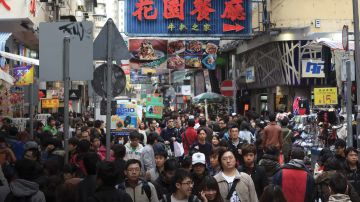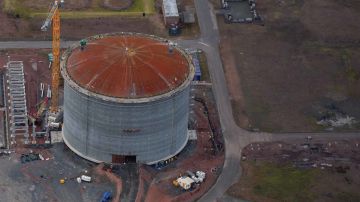The world is filling up. Sustainability must be at the top of everyone’s agenda if we are to survive as a species on a planet with limited natural resources. But with the global population expected to top nine billion in 2050, how can we do both? It’s become the nine billion people question. And opinion is divided
BRITAIN’S best-known natural history film-maker Sir David Attenborough is not a man to mince his words. Neither is he prone to exaggeration.
Over the past four decades, he has seen parts of the natural world destroyed by mankind to such an extent that animals no longer exist. He has literally witnessed nature change in front of his eyes.
And he blames the growing population.
“I have no doubt that it is the fundamental source of all our problems, particularly our environmental problems,” he said in a recent interview with The Wellcome Trust. “I cannot think of a single problem that wouldn’t be easier to solve if there were fewer people.”
He said during his career, the world’s population had tripled.
“If we are able to stem it, we might have a better chance to grapple with the problems but we cannot,” he said. “The best we can do is slow down the rate of increase. I thank God that the Trust has administrators who are scientists, not politicians.”
Last year in an interview with INCH magazine, Jonathon Porritt, one of the world’s leading environmentalists, said he too was putting his faith in the chemical industry to play a pivotal role in tackling the challenges of sustainability.
And it is.
Since the first historic Earth Summit in Rio de Janiero in 1992, the global chemical industry has helped to enable farmers adopt sustainable agricultural methods and ensure more and more people can access cleaner, safer drinking water.
Further work has led to medical breakthroughs, transformed the way energy is used and helped to cut greenhouse gases.
The International Council of Chemical Associations, the worldwide voice for the chemical industry, said such progress had been the result of innovative ideas, technologies and processes all made possible through chemistry.
INEOS is one such company which works to develop innovative, sustainable solutions to complex and challenging issues because it recognises that it can have enormous influence on what the world does now – and in the future.
One of its products that makes a huge difference to the world’s nutrition and health is acetonitrile, which is used to make essential drugs such as insulin and antibiotics, and also plays an important role in treatments for cancer. The clear, liquid solvent is also used to produce agrochemicals which ensure higher crop yields. INEOS currently meets about half of the global demand for acetonitrile. And much of what it doesn’t produce is manufactured by others using its licensed technology.
There is no doubt that humanity faces profound questions about how the planet is to sustain nine billion people beyond 2050. Demand for food is rising, natural resources are challenged, and climate change has created a need for new, lower carbon energy sources.
Tim Benton, a professor of population ecology at the University of Leeds in the UK and a food security expert, said people had to understand – and recognise – the finiteness of the world to give us what we want.
“It is the only way we’ll ever approach sustainability,” he said. “Demand is the killer. And unless we tackle demand, we will over exploit land and water and accelerate climate change.”
By 2050 the planet will have to feed a third more people but there is only so much land that can be farmed.
“Surely technological advances will make our use of land more efficient, but we cannot extract ever more from ever less,” said Tim. “The only way we’ll ever approach sustainability is to moderate our demand.”
He said the world currently produced enough calories for 12 billion people but people in the developed world ate too much, a good proportion went to feed livestock and the rest was wasted.
“It’s not about formulation and individual nutrients, or 3-D printers,” he said. “It’s about building resilience, reducing waste and modifying our diets. In future, the agriindustry cannot persist with the ‘demand is growing, we have to supply it at all costs’ mentality. It simply has to change.”
Friends of the Earth, which has been campaigning for more than 40 years to improve the well-being of the planet, recently launched its Big Ideas Change the World, a three-year project.
A spokesman said the extreme pressure that people, predominately those in developed countries, had put on the planet needed to be significantly and rapidly reduced.
“It is a herculean challenge and, without a global population peak this century, it may well be impossible,” he said.
But opinion, about whether the world is doomed or not, is divided.
“It has been a race between the exhaustibility of resources and innovation and so far innovation has won,” Citi’s chief economist Willem Buiter recently told INCH magazine. “We have several thousand years of human history to support us on that so I am reasonably optimistic.”
Robert Aliber, a professor of international economics and finance at Chicago University, said he too remained untroubled.
“Thomas Malthus predicted in 1798 that unchecked population growth would doom the Earth to starvation,” he said. “He has been proved wrong for the past 200 years so why should he be right in the next 100?”
Overcrowding is a problem in some corners of the world. That’s a fact that cannot be denied.
Award-winning Danish photographer Mads Nissen said he witnessed the problem of too many people living in too little space when he visited Manila in the Philippines nine years ago.
In 1980, 50 million people lived in the Philippines. That number is expected to rocket to 180 million by 2050.
“Manila is already one of the most overpopulated places on earth,” he said. “Families live in home-made shacks built in cemeteries, or between railroad tracks or under bridges. They live wherever they can find some space. Even the city’s toxic garbage dumps are home to people who eat, sleep and live surrounded by rotting trash.”
But the World Population Balance believes that the future can be changed in a humane way.
“We can create a new vision, a new dream for the planet,” said founder and president David Paxson.
He said the solution was a global campaign to encourage people throughout the world to have fewer children.
“Today we are spending millions to create a more sustainable planet but all we are getting is a more polluted one,” he said. “Sustainability on an overpopulated planet is impossible and the world is significantly overpopulated right now.”
He claimed two billion people now lived in poverty. “That is more than the population of the entire planet less than 100 years ago,” he said.
Mr Paxson said it would be an uphill battle to successfully cut the population but nothing compared with coping with overpopulation’s devastating consequences.
The debate over how on earth we can feed nine billion people will continue to divide opinion.
But as that debate continues, it falls to the chemical industry, which is at the start of almost all other industry, to continue to focus its efforts on producing essential items to help tackle many of the issues presented by an ever-changing world – in a more efficient way and in a way that not only reduces its own impact on the environment, but also the impact of industries it serves.
And it is not just about saving money. INEOS knows it has a huge responsibility to provide the materials necessary for the technologies of tomorrow, to use fewer raw materials to help society to consume less energy in a world with finite resources.
That is why you’ll find INEOS at the heart of the chemistry behind our basic human needs. The need for food, transport, communications, water. And for energy.
It has been providing that chemistry for years. And it intends to do so for generations to come.
















